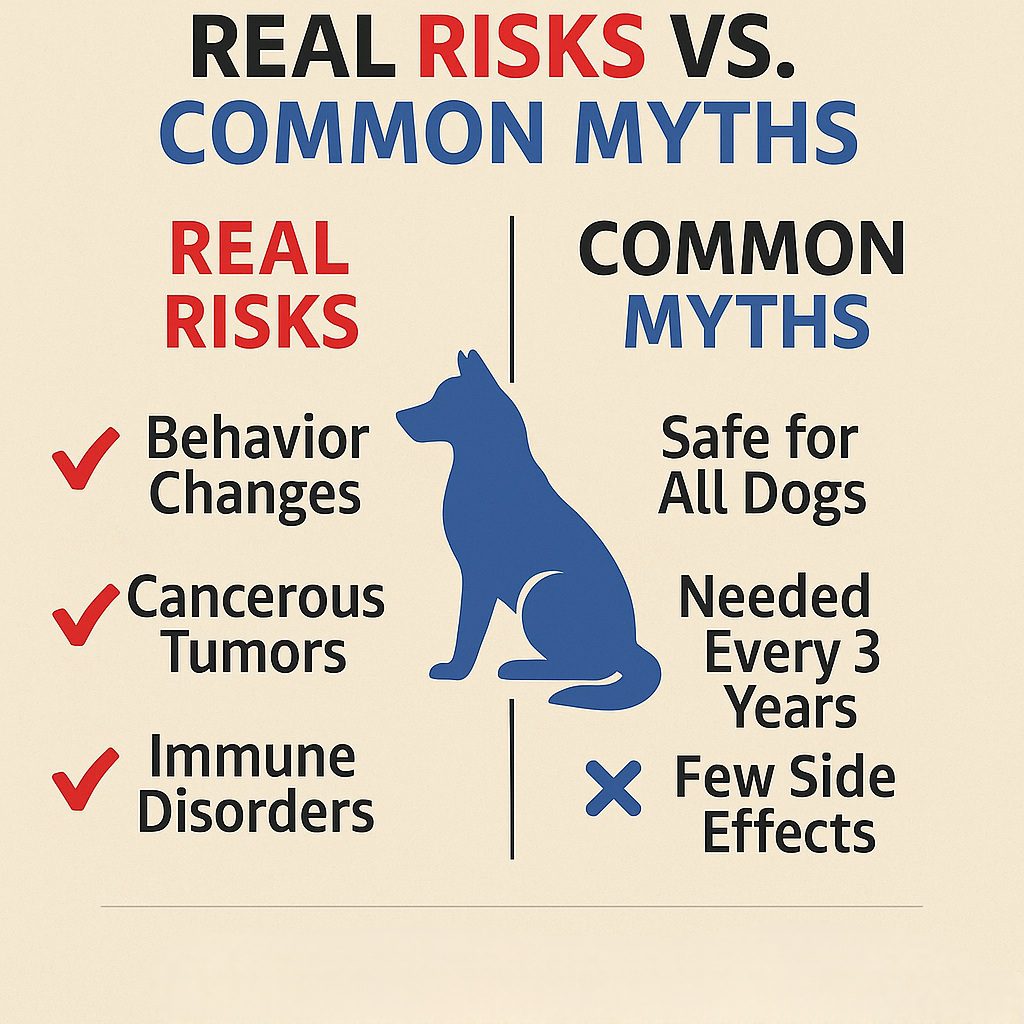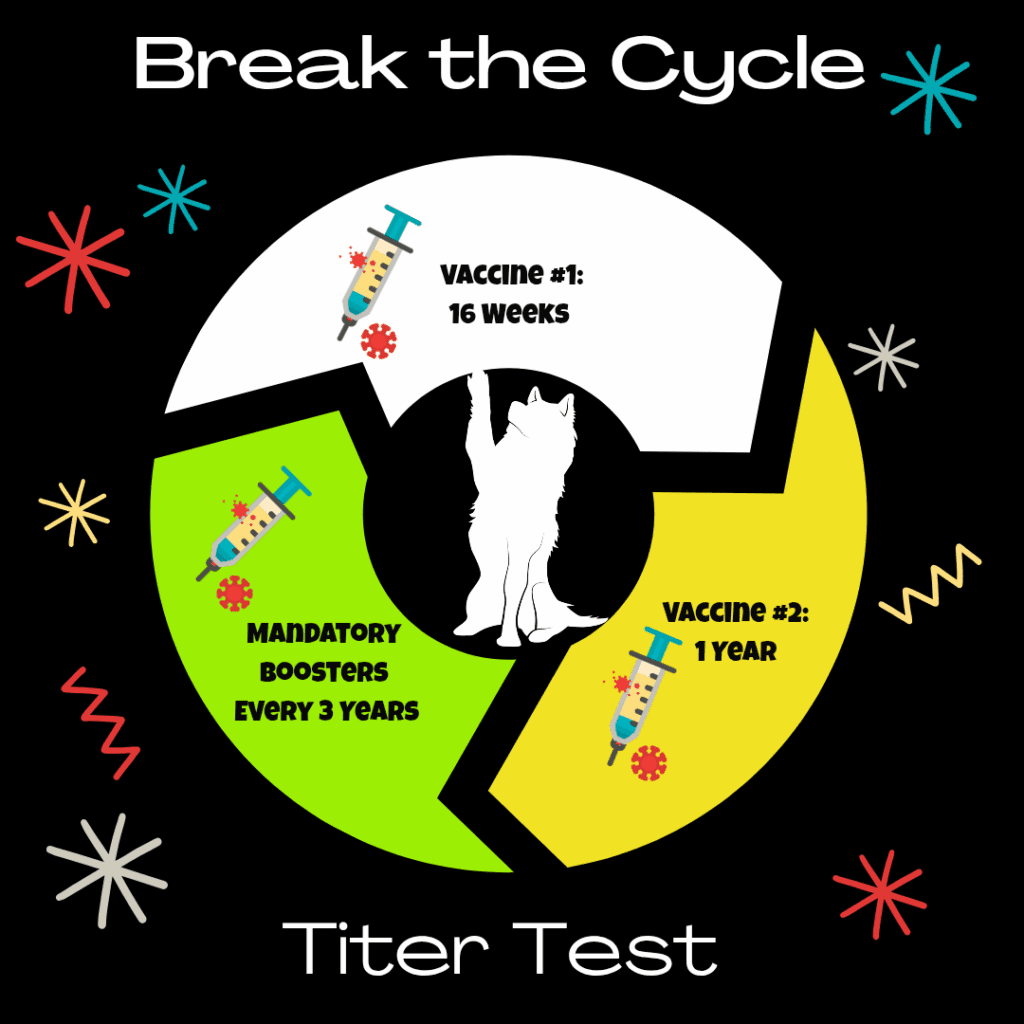1. Rabies: The One Vaccine You’re Legally Forced to Give
Across the U.S. and much of Canada, rabies is the only legally mandated vaccine—required by law for all dogs, regardless of health, age, or immune status. But while the law treats this vaccine as untouchable, science tells a different story.
At NAIDPP, we’ve seen the truth with our own dogs: rabies immunity lasts a lifetime—just like other core vaccines. So why are we still being forced to repeat it again and again?
2. What the Science Actually Says
Multiple studies—and years of real-world experience—now confirm:
Rabies vaccines often provide lifetime immunity
The 1-year and 3-year vaccines are chemically identical
There is no medical benefit to repeated boosters when titers confirm immunity
We’ve titer tested our own NAIDs into their senior years—still protected, with no boosters for as long as seven years (and counting).
But you won’t hear this from your average vet… because the system isn’t designed to listen to evidence.

3. The Dark Side of the Rabies Vaccine
Rabies is a neurological disease. So is the damage from its vaccine.
Every booster increases the risk of:
Aggression and fear-based behavior
Seizures and brain inflammation
Chronic allergies or autoimmune flare-ups
Rabies miasm – a syndrome of rage, paranoia, and instability often dismissed or misdiagnosed
Cancers (especially in cats and small breeds)
Most owners never connect the dots.
In fact, rabies vaccines in cats are often injected in the tail so the tail can be amputated if a tumor forms. That tells you everything you need to know.
4. Vaccine Injury Denial Is the Norm
Here’s the harsh truth:
The more often your dog receives rabies vaccines, the more likely they are to suffer.
But if they do, the system won’t admit it. Instead, you’ll be told:
“It’s just genetics.”
“It’s behavioral.”
“It’s age-related.”
Or worse—“It’s unrelated.”
Veterinary medicine almost never attributes chronic illness to over-vaccination. But when side effects do occur, they can be severe—and irreversible.
5. The Politics of Fear and Profit
So why does this continue?
Because rabies is big business.
Because fear sells.
Because changing policy means changing control. And not everyone wants that.
Our friend, a holistic vet in Massachusetts, was targeted by the Veterinary Medical Board for writing vaccine waivers for senior and immunocompromised dogs. Dogs who were proven immune via titers. Dogs who would have been harmed by a booster. They came for her anyway.
When protecting your patient becomes a punishable offense, the problem isn’t the practitioner—it’s the system.
Meanwhile, government agencies have been experimenting with wildlife vaccination using bait and oral rabies vaccines—without public input.
Is this public safety or population control? When you start pulling at this thread, things get uncomfortable. And revealing.

6. What You Can Do Instead
You are your dog’s only advocate.
You have more power than you think. Here’s how you can protect your dog:
Titer test for rabies before agreeing to another booster
Request a rabies waiver if your dog is a senior or has a medical condition
Find a vet who aligns with your values and supports science-based exemptions
Educate yourself and ask questions—don’t assume the law is based on logic
Join the movement to petition for legal changes that allow titers in place of mandatory vaccination
This is a consumer-driven industry.If we speak with one voice, we can change it.
7. The Older Your Dog, the Higher the Risk
As your dog ages, their immune system changes.
The same vaccine that caused no issue at 1 year old can be devastating at 7 or 10 or 13.
At NAIDPP, we do not vaccinate dogs over the age of 6 for rabies or any other disease—as long as titers prove immunity. And we encourage every owner to seek a waiver for their senior dog if your vet will write one.
Can’t find a vet who will?
Find a new vet.The right one is out there. And your dog deserves their care.
8. The One-Year and Three-Year Rabies Vaccines Are the Same
Here’s another truth most vets won’t tell you:
There is no difference between the 1-year and 3-year rabies vaccines.
They are literally the same shot, in the same dose. Yet we’re told to come back sooner for one than the other—because it drives repeat visits and revenue.
Also disturbing:
There’s no dose adjustment for size or age.
A 10 lb Chihuahua gets the same shot as a 120 lb Pyrenees. That’s not science. That’s laziness—or worse, profit-driven care.
9. Final Thoughts: Speak Up. Stand Tall. Protect Your Dog.
You don’t need to stay silent. You don’t need to follow rules that hurt your dog out of fear or guilt.
You can ask for titers.
You can say no.
You can demand better.
This is your dog. This is your responsibility. And this is your opportunity to be the voice they can’t raise for themselves.
The change begins with us. Refuse what harms. Protect what matters. Speak up—for their sake.

